Trout Flies: Our Ultimate Guide
A guide that cuts through the bewildering number of different patterns and schools of tying trout flies…Helping you to decide what to buy or what to tie – with secrets from some of today’s best tyers and anglers.
Click to Skip to Paul Procter’s Dry Flies
Click to Skip to Martin Smith’s Streamers
Click to Skip to Steve Cullen’s Reservoir Flies
Click to Skip to Ben Fox’s Small Stillwater Flies
Click to Skip to Robert Smith’s North Country Wet Flies
Click to Skip to Japanese Tenkara Flies
Click to Skip to Paul Molloy’s Quill Nymphs
Click to Skip to Suppliers’ list
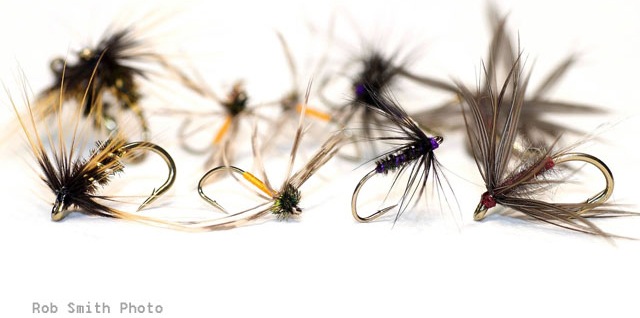
Basic Introduction to the World of Trout Flies
Of course the absolute most basic definition that you can apply to any trout fly is whether it is a “dry fly” (floating on or in the water’s surface) or a “wet fly” (sunk beneath the surface). As we’ll see though, there’s a LOT of scope for variations – both subtle and blatant – within those basic definitions…From “damp dries” to “emergers” to jig-head streamers and everything in between.
In line with the incredibly varied “personalities” (and even sizes) of trout themselves, the huge differences in the environments that they live in and the food that’s available for them to eat creates an overwhelming range of potential imitations for the fly dresser…For example:

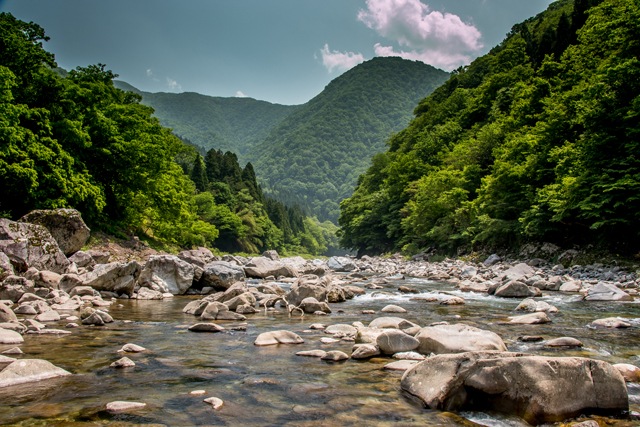
Another way to say it is that the massive range of lakes, loughs, rivers, streams, creeks, reservoirs, pools that trout swim has inspired an equally huge variety of trout flies. Because the trout are so adaptable – fly tiers have needed to be really inventive over the ages in order to target them effectively.
Oh, and then you get to superimpose a few hundred (and in some cases a few thousand) years of history and tradition in the arts and methods of tying trout flies…
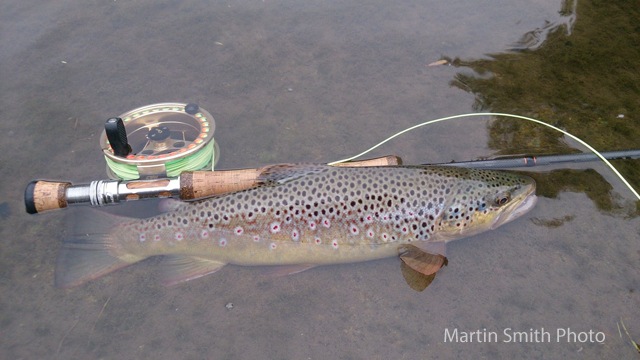
By introducing these different “schools” of trout flies, it’s also a bit easier to see where Japanese tenkara flies (which are much misunderstood) sit in the global story of traditional and modern trout flies.
All of that variety is pretty tough to deal with – whether you want to know where to buy your flies or what you should be tying for your next trip. Here’s our guide to (at least) a fair cross section of trout fly patterns – covering modern and traditional and well as still and flowing water.
Traditional Trout Flies
I should probably call this section “Trout Flies with a Long Tradition Behind Them”. What I mean is, just because these patterns have such long histories – it doesn’t mean that they don’t continue to be developed and tweaked today. At the same time, it is fascinating to be able to look back and see what tyers of bygone ages were creating and using. Also, because all of the information available at the moment points to a MUCH longer history for wet flies (likely to be thousands rather than hundreds of years); I’ve placed dry flies into the “modern trout flies” section of this guide. Of course, the history of dry fly fishing around the world is hugely important within our sport and I do my best to pick out some key points (with useful links) in the “dry fly” section. But first…
Traditional Stillwater Patterns: Irish Lough Trout Flies
I think a fantastic example of “Flies with a long Tradition Behind Them” is the school of tying that you find on the great loughs of Ireland. The flies that are in use today have their local, traditional style deep in their DNA. The use of colour, contrast, mobility – and the ability to disturb the water around them – are all essential characteristics. Something to pay particular attention to (on top of the mobility/water-moving characteristics) of these flies is the deliberate contrast to the colour of the peaty (whiskey-coloured) water.
At the same time, understanding how the quality of the daylight can change which are the most noticeable and/or preferable patterns to the fish on a given day is central to this style of fishing. This is why you’ll see the use of claret, golden olive, bright “picric” yellow and various black mixtures in the body dubbing – as well as the use of jungle cock “eyes” – in many patterns.
In the main, these patterns are designed to be cast in front of a drifting boat and (when fished on a floating line) with a relatively long rod and “stripped” a few times before being re-cast. Typically a team of 3 flies will be used and, in the most traditional “shortlining” method, the rod tip will be held high – which keeps line off the water (minimising the chances of spooking fish) and also allowing the top dropper fly (often known as the “bob” fly) to be worked through the surface film. This acts not only to attract fish to that bob fly – but also draw attention to the other two flies as well.
Modern tactical variations that include sinking lines and longer casts have been incorporated over recent decades (often following developments in competitive angling on the drinking water reservoirs around the midlands of England).
Here’s pro-tyer Jackie Mahon with more info – right from the source:
Jackie Mahon’s Irish Lough Wet Flies
Hi, my name is Jackie Mahon I live in Sligo which is on the west coast of Ireland. I live close to Lough Melvin and Lough Arrow, which I provide a guiding service on. I am a professional fly dresser. My flies are mostly tied for Irish lough style fishing. My flies vary from traditional to modern style. I use all kinds of materials some which I dye myself to get the traditional Irish colours. I tied my first fly when I was ten years old. I have been fly fishing since the age of nine.
You will find me on Facebook and Instagram under “Jackie Mahon Flies & Guiding”
Email – Mahonjackie@gmail.com
These are the tyings of my flies:
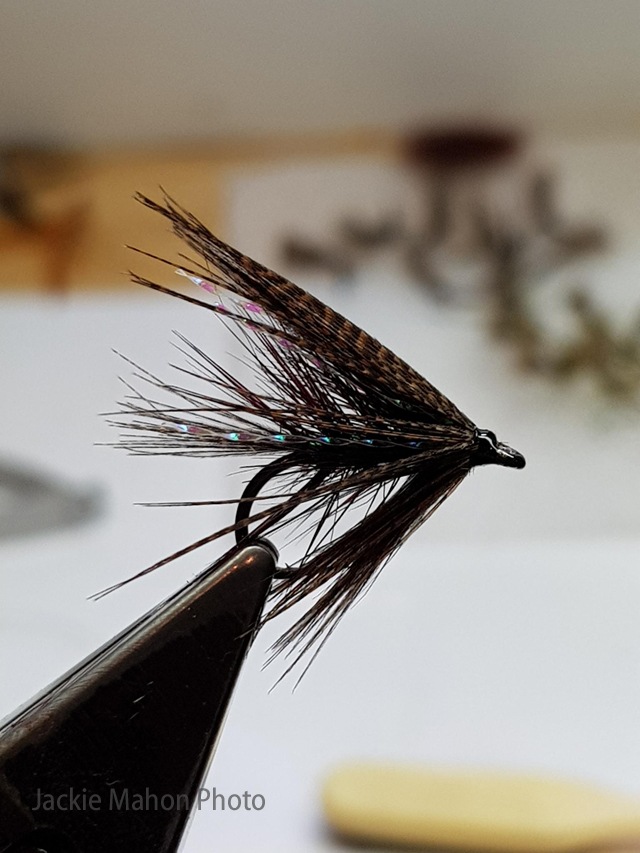
BLACK CLARET DABBLER [MELVIN]
Thread – Black
Tail – Bronze mallard
Rib – Uni Mylar pearly
Body – Black claret seal fur
Body hackle – Black claret hackle
Under wing – Pearl crystal flash
Wing – Bronze mallard
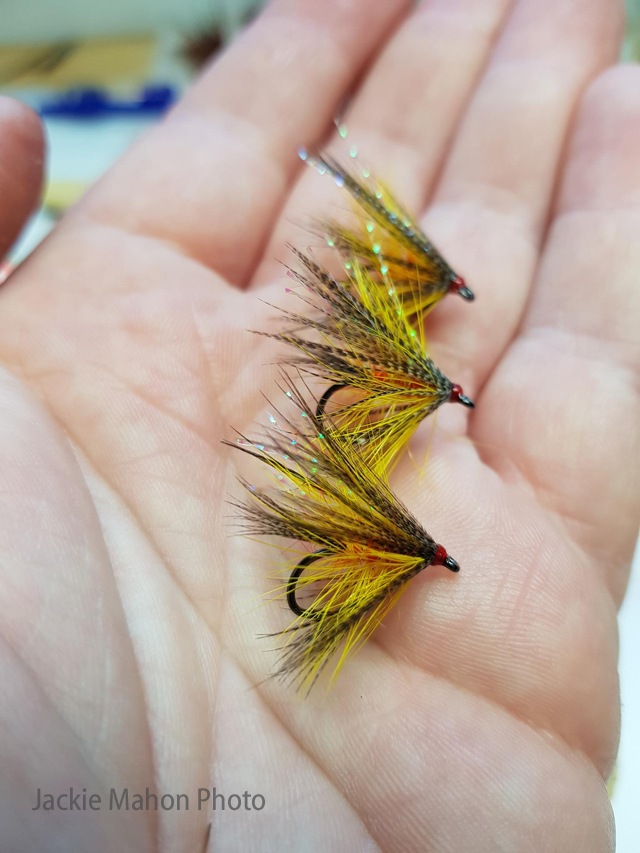
GOLDEN DABBLER
Thread – Red
Tail – Bronze mallard
Rib – Gold tinsel
Body – Sunburst seals fur
Body hackle – Picric yellow hackle
Under wing – Pearl crystal flash
Wing -Bronze mallard
Jackie came up with the next fly for the Police International Competition on Lough Corrib. He was tying for the Irish team and they won the competition on it… The team had 22 fish and 13 of those were caught on his new fly – which he called The Bandit Dabbler:
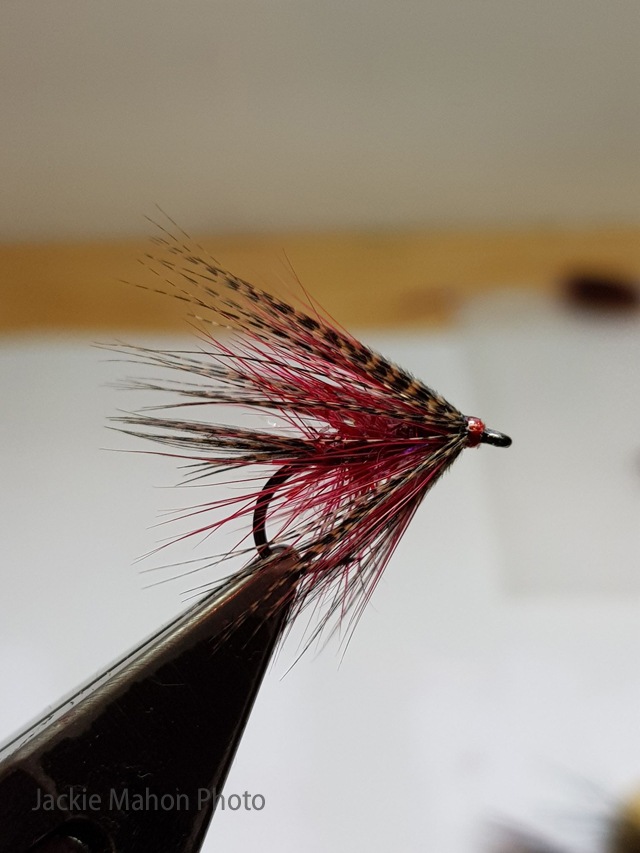
THE BANDIT DABBLER
Thread – Black
Tail – Bronze mallard
Rib – Red wire
Body – UV Fritz’s dyed in Melvin claret
Body hackle – Melvin claret hackle
Wing – Bronze mallard
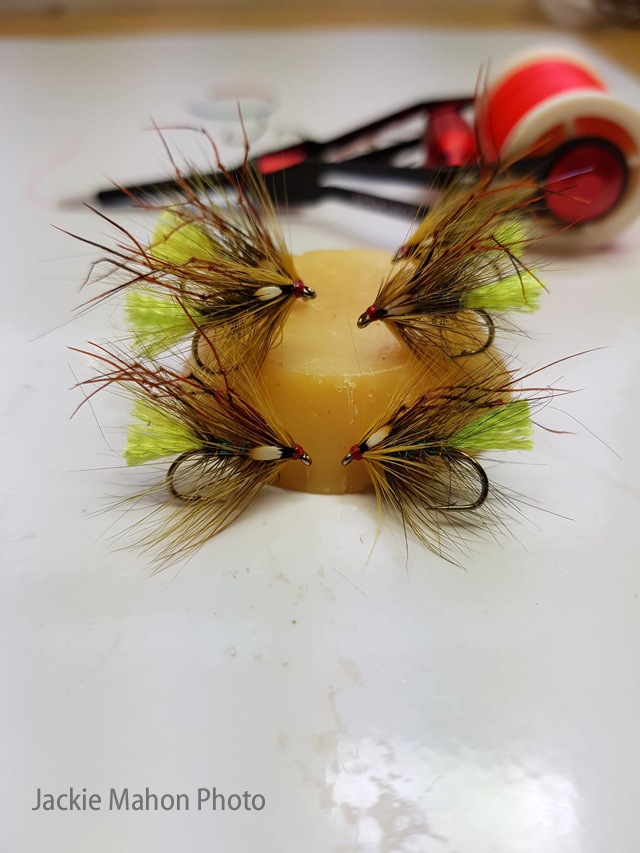
DASHING GEORGE
Thread – Red
Tail – No11 Globrite
Rib – pearl Uni Mylar pearl
Body – Dark olive seals fur
Body hackle – Dark olive
Legs – Knotted pheasant tails dyed orange
Front hackle – Ginger dyed Irish golden olive
Cheeks – Jungle cock
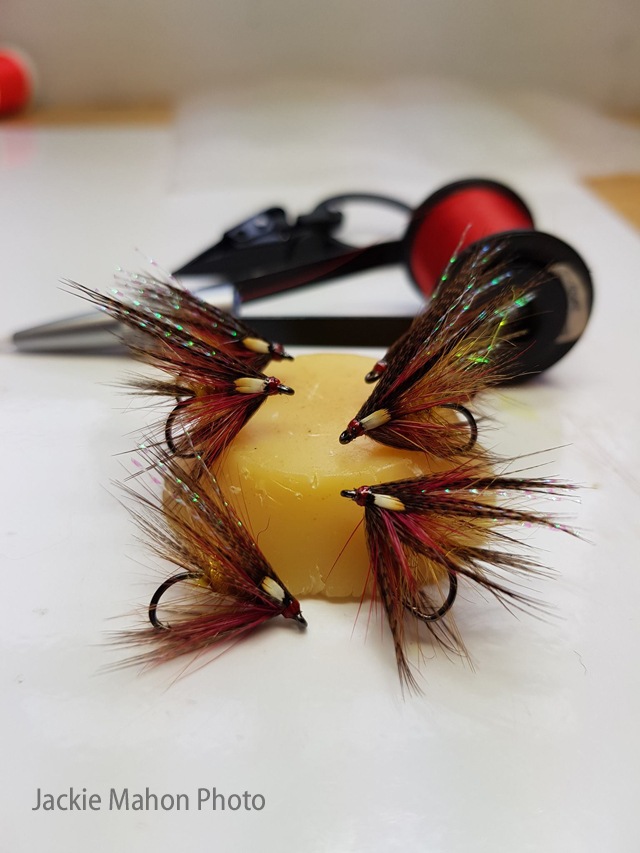
COCK ROBIN DABBLER
Thread – Red
Tail – Bronze mallard
Rib – Gold tinsel
Body – in two halves:
Back half – Picric seals fur
Front half – Melvin claret
Body hackle – Ginger dyed picric then two turns of Melvin claret hackle (in front)
Underwing – Pearl crystal flash
Wing – Bronze mallard
Cheeks – Jungle cock

OCTOPUS
Thread – Fluoro orange
Tag – Old Irish gold tinsel
Tail – No11 Globrite
Rib – Hot yellow wire
Body – Picric seals fur
Body hackle – Picric yellow hackle
Front hackle – Rump pheasant dyed sun burst
Of course, you can equally look to the traditions of Loch and Llyn fishing in Scotland and Wales for fascinating, historic, stillwater patterns too (and many more). The rich culture of the great Western Irish Loughs is a wonderful place to start though! You’ll not find finer-tied examples of these wonderful trout flies than those Jackie has kindly shared here.
Traditional Trout Flies for Rivers
Robert Smith’s North Country Trout Flies
Robert Smith of www.northcountryflies.com quite literally wrote the book on these fantastic patterns (if you’ve not read “The North Country Fly: Yorkshire’s Soft Hackle Tradition” – you should really find yourself a copy via Google).
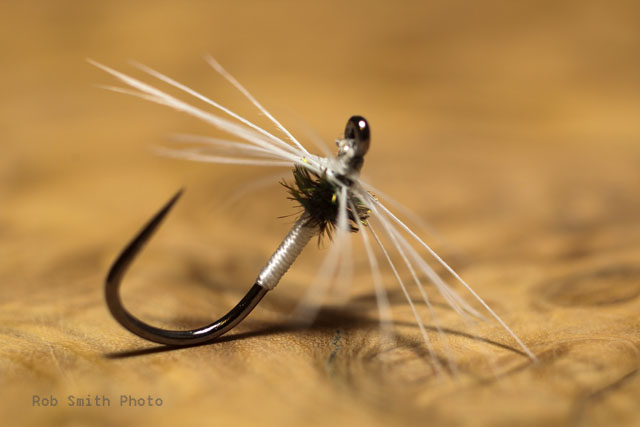
The interwoven stories of the patterns, the people and families who developed and shared them and the rugged moorland landscapes make the history of North Country flies read like a “Game of Thrones” epic. I love the simple, impressionistic characteristics of this whole school of fly tying and fly fishing. I also love that the different strands of that story have crossed continents and oceans before landing in the wild North of England – tied up with religion, wealth and eventual ruin. For a “prequel” part of that amazing back-story – check out the ancient style of tying still practised in Sesia, Italy to this day (and which represents the likely form of ancestral patterns that travelled to England, piggy-backing on the arrival and spread of Christianity)
Robert tells me that his friend “Terry” had historic fly lists and actual flies belonging to Sylvester Lister, one of the founders of the Burnsall Club, and in many ways the grandfather of flyfishing in Wharfedale (at the heart of the North County Fly Tradition). Terry was also friends with Vincent Marinaro (famous American dry fly authority) and shared all these flies and fly-lists with Marinaro over several years, if you read Marinaro’s book he mentions sparse soft-hackle flies out-fish all others…
So it came to be that Marinaro, the professor of American dry fly fishing, was fishing North Country spiders at the end of his life, and the last trout he ever caught was on a North Country Spider.
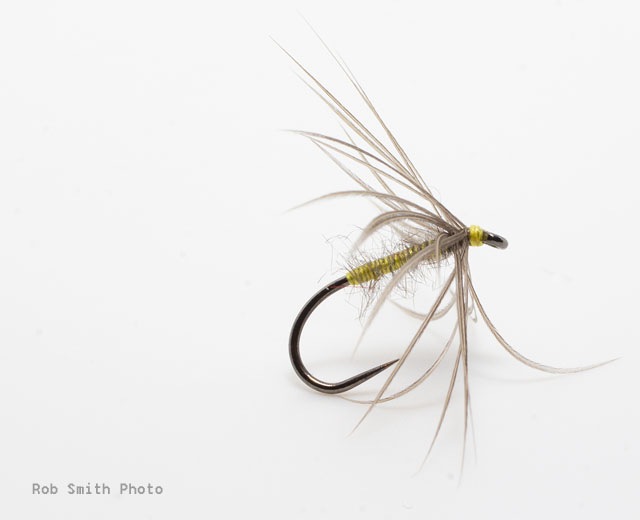
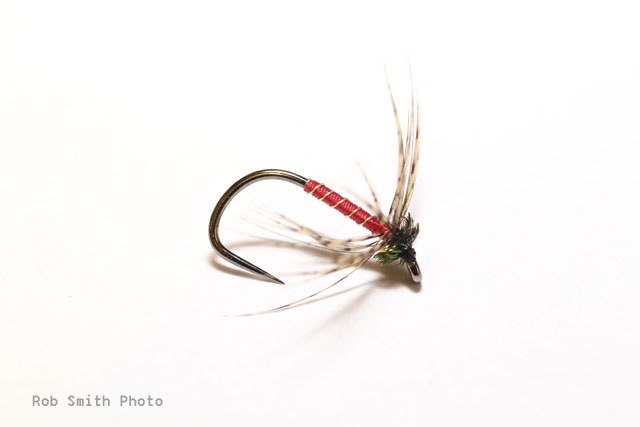
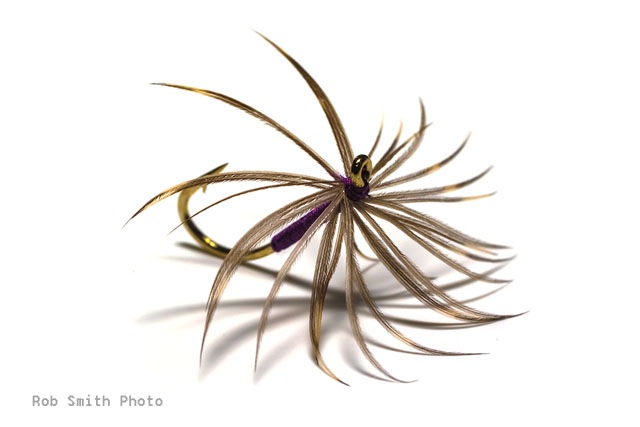
One of the great things about Robert Smith’s personal archive of actual fly specimens (often dressed directly onto horse-hair tippet) is that it makes it very easy to challenge the modern “fetish” for only ever tying North Country Spiders with a very sparse hackle. Yes, in the right conditions that sparse hackle will be deadly – but it is far from the normal or only way that they should be tied and fished. In actual historic specimens, bushy (and even clipped) hackles wound many, many times around the hook shank are very common. These flies are designed to be (and should be) fished at any angle to the current – from upstream, to across to downstream.
Copying the original style of long rod, light horsehair casting line and the same “high rod tip” position seen in traditional Irish Lough-Style “Short-lining” will hugely increase your success rate (those original anglers knew a thing or two about catching trout).
Both British and Continental European methods for fishing these simple wet flies used rods with no reels and fly lines made from twisted horse-hair; Just like…
Japanese Tenkara trout flies
Growing up as a fly fisher in Lancashire and Yorkshire (and now probably disowned by both “shires” ha ha), I’ve always had a soft spot for the North Country style of flies. Perhaps my existing love of those patterns made it easy for me to see the value in the Japanese flies used in the traditional form of fly fishing in Japan. The fly fishing style is known as tenkara and the flies are called “kebari”.
Although designed to target the char (iwana) and trout (amago and yamame) of Japan, these patterns have turned out to be incredibly effective as trout flies all around the world – regardless of the species of fish you target and where your rivers are on the globe. There’s an entire article dedicated to kebari on our site here. Also, we’ve boiled down the vast range of patterns that we’ve been fortunate to be shown by all the great anglers we meet in Japan into a “go anywhere” range of just 12 patterns.
Here’s a quick “myth-busting” rundown of some of the FUNCTIONAL things you need to know about kebari:
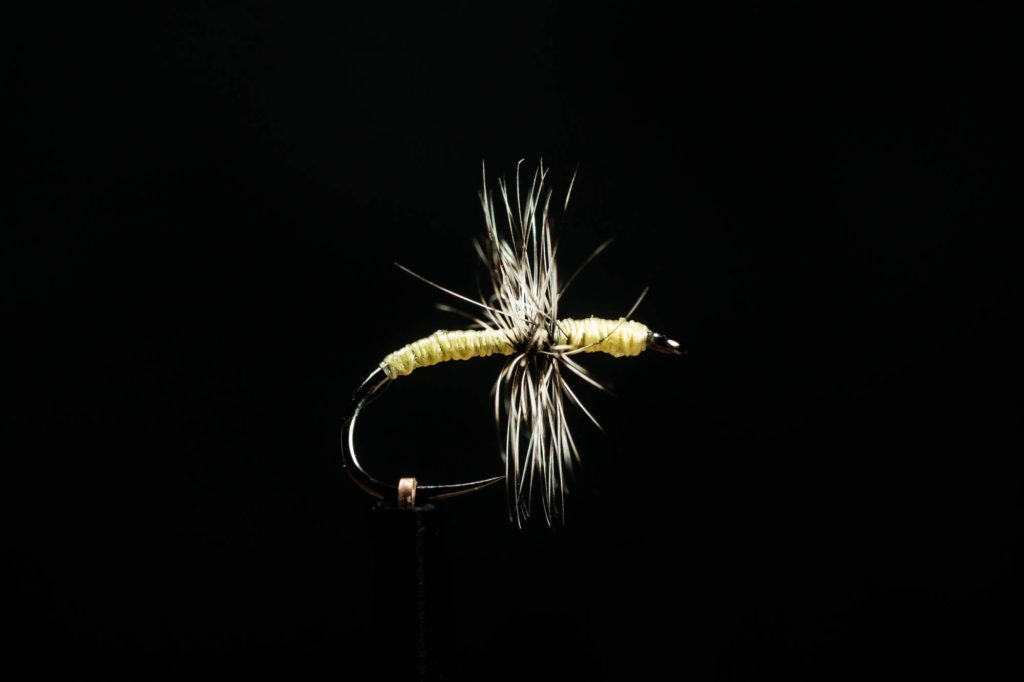
Stiff hackled flies are very often used to “anchor” in currents below the surface of the water (either static or used to draw out the casting line held off the water across the stream). These patterns are often labelled as “tenkara dry flies”, but this is a common myth. They are stiff-hackled wet flies (something that Englishman H. C. Cutcliffe would definitely have approved of for his “Art of Trout Fishing in Rapid Streams”).
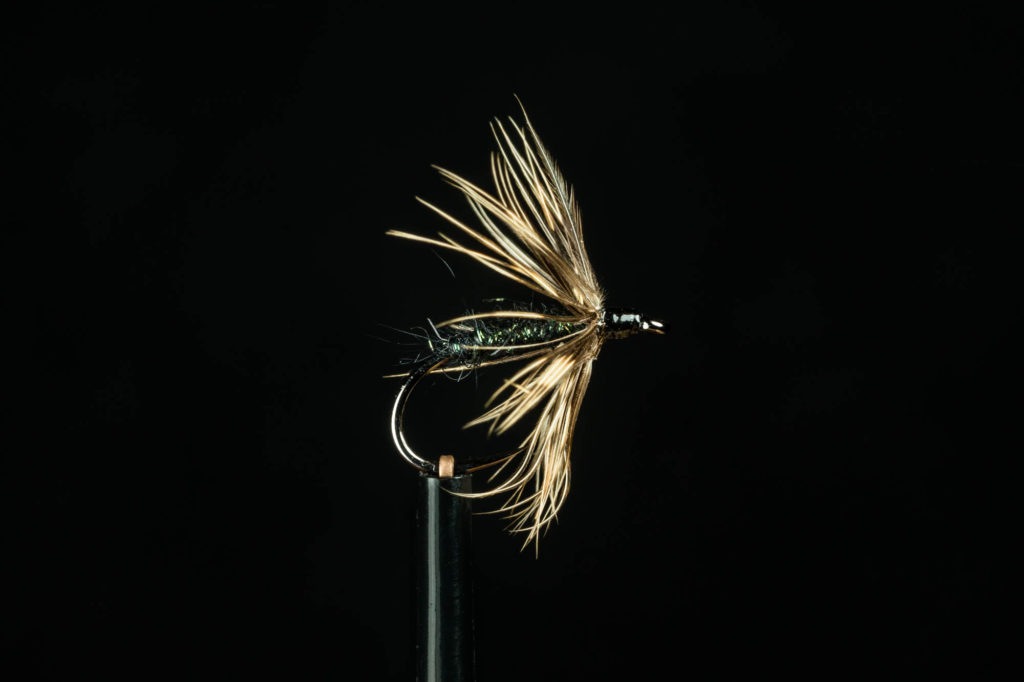
Conventional (swept-back) soft-hackled flies commonly known as “Jun Kebari” in Japan. These trade heavily on the mobility of the hackle fibres in the water and very much resemble many trout flies in the west that are designed to be fished “wet”. It’s no mistake that this basic, overall design crops up in everything from river wet flies to traditional stillwater patterns anywhere that trout swim. They look like food, they move like food and so – to trout – they are food.
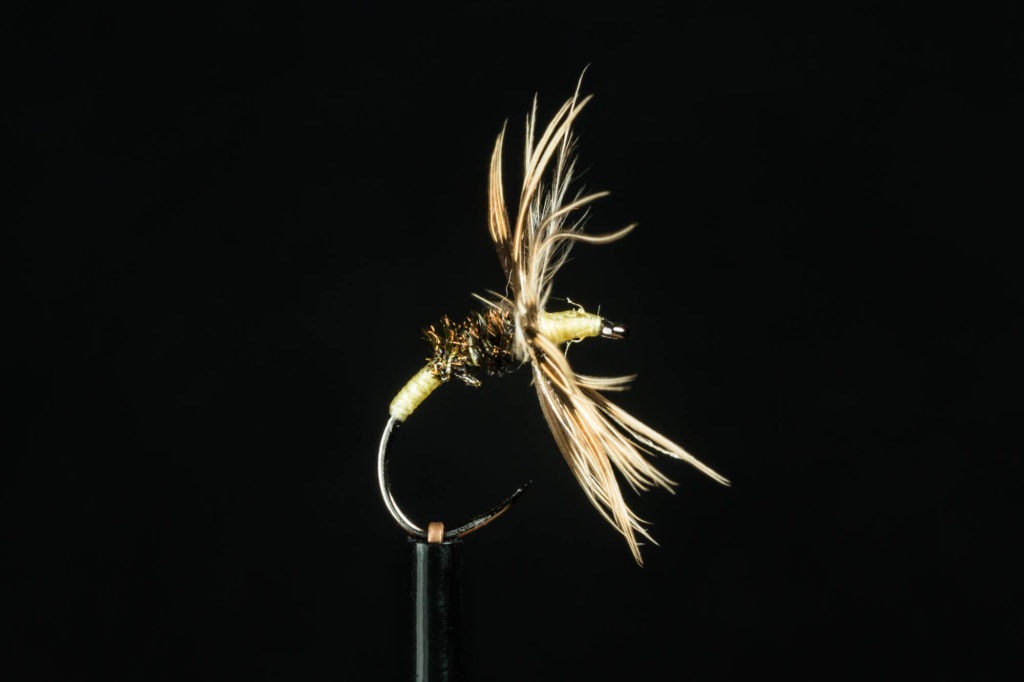
Reverse-hackled wet flies. Iconic – yet still a minority – style of dressing Japanese tenkara flies. As well as excellent pulsation of the hackle when manipulated, these flies are also brilliant for dead-drifting downstream of the angler (where the dish of hackle picks up the flow beautifully). Notice that, aside from the hackle material, the pattern pictured here has quite a lot in common with the July Dun featured in the North Country Spiders section.
Naturally (given the address of this site), quite a lot of content on our pages is dedicated to uncovering and sharing all those little-known tactics, stories and people involved with fishing kebari. If you don’t think much of tenkara, there’s a decent chance that this is due to the poor job that western industry players have (so far) done in actually discovering and sharing how rich authentic Japanese tenkara actually is!!
Modern Trout Flies
Reservoir Trout Flies for Stocked and Resident Fish
England in the 1960s saw the opening of large drinking water reservoirs to fly fishers. Fish stocked into those productive waters quickly grew and the reputation for fast and furious sport soon spread. Over the years, a vast number of patterns have been developed for teasing, tempting and fooling the fish in these large water bodies. Some are designed to provoke – and others are full-on imitative fly patterns that imitate a range of prey from insects to baitfish.
The productivity of many of these waters leads to an interesting split in the characteristics of fish that you can target. Firstly, there is an opportunity to “provoke” an aggressive (or a curiosity) response from recently-stocked fish. This fishing style will tend to focus less on imitative trout fly patterns.
Secondly, there are the “grown on” and “overwintered” fish that have adopted much more naturalised behaviours and feeding-patterns. These fish can respond to a combination of provocative as well as imitative trout flies. They can also be of large size and in extremely strong, fighting-fit condition. This seems to be particularly true when they are locked on to feeding on shoals of natural bait-fish (the “fry bashing” behaviour that reservoir trout fly fishers look forward to each year).
Steve Cullen’s Reservoir Trout Fly Selection
Steve Cullen has a ton of experience at the cutting edge of development and use of patterns in his capacity as competitive reservoir fly fisher, previous magazine editor (Total Flyfisher), photographer, Fly tyer and current Brand Manager at Leeda/Wychwood. Here’s an incredibly valuable peek into his fly box for some “insider secret” trout flies for targeting reservoir fish.
You can see more of Steve’s Patterns and find insights behind this selection by connecting with him on his Facebook profile. and his Instagram.
I’ve added some comments below each of Steve’s patterns (and may not be related to his own thinking on each pattern!). Instead they are thoughts that come from my own experiences with reservoir trout fishing and freshwater biology.
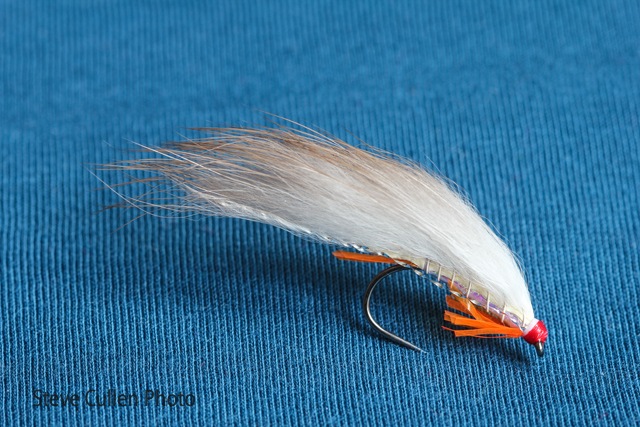
Appetiser Minkie
Starting out with a fantastic pattern to target those “fry-bashing” naturalised and overwintered fish – the original “Appetiser” was a classic Bob Church lure that used white marabou and squirrel wing. The addition of modern translucent orange fritz in place of the classic cock hackle and strands of reflective twisted pearl add some great attraction. Anyone who has seen a wet mink strip wing in the water will know what a perfect bait-fish imitation this produces. So don’t be fooled into thinking this is just a non-specific attractor “lure”, it will have some of those properties – but it is an excellent direct imitation of young bait-fish too. Use whatever line and rig will get this to the feeding depth of the fish (as with all reservoir flies, aim to be able to hold it within an approximate 2-foot “band” – whether that is 0 to 2ft deep, 4-6ft deep, 18-20ft deep or whatever! Change line densities and profiles (and mess about with the buoyancy or sinking properties of the flies on your cast) in order to find and stick to that feeding band.
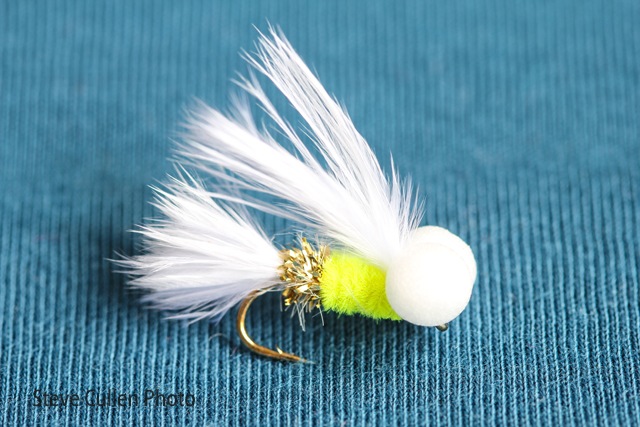
Gold-ass Cat’s Whisker Booby
As I mentioned above for Steve’s Appetiser variant, the ability to control the depth of your fly by tricks other than the density/sink-rate of your fly line is vital in reservoir trout fishing. The creative use of neutral-buoyancy or positively buoyant flies at different positions on your droppers or the “point fly” position is the key to those tactics. As one basic example – the “washing line” approach uses a booby on the point fly position (and sometimes one on the top dropper too) to suspend the dropper flies in a flat plane between the tip of your fly line and the very end of your tippet (or “point”).
The original boobies were designed to be fished on very short leaders (maybe 2ft long) and super-fast sinking lines – so that the line would lay on the bottom of the lake and the fly could be retrieved very slowly while hovering just above the bed. This proved to be a deadly tactic in either very cold or very hot conditions in deep water. However, that static or very slow presentation often results in deeply-hooked fish (so is only really suitable when you are keeping fish to eat). By contrast, the later developments that sees boobies used on longer leaders and more active retrieves/take-detection avoids that deep-hooking issue.
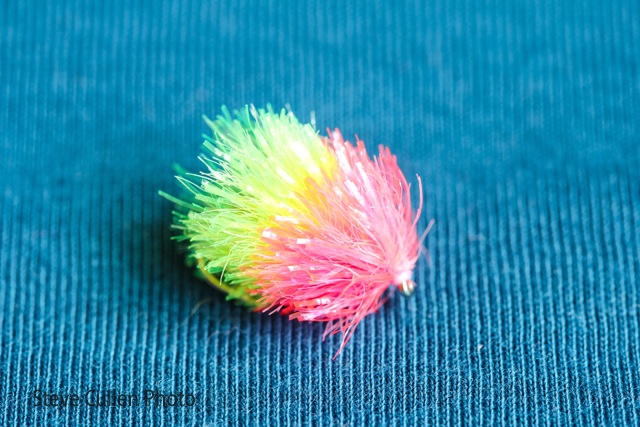
Blob
An out and out “lure” (a fly whose sole aim is to provoke and tantalise through aggression and curiosity) and one of the most effective tools in that role ever devised. Often controversial – and not to everyone’s taste – don’t be fooled into thinking that all blobs are equal. There’s a knack to packing on enough turns of fritz material to create the ideal high density of material (be careful not to spike your thumb when packing the turns together and keeping each wrap laid in front of the previous turn). In addition, make sure that you use a wide-gape hook – and/or be ready to trim the underside of the dressing if you need to expose the hook point.
Although famous for being retrieved (stripped back towards the angler) as fast as humanly possible – make sure to experiment with a whole range of retrieve styles and speeds. Also, don’t underestimate the effect of “sandwiching” imitative flies between a pair of blobs – with the bright lures drawing attention and the natural “food” imitating patterns “closing the sale” for savvy fish. Look out for the new varieties of translucent and/or “UV” fritz material developments as they continue to come along. Take care to note the maximum number of flies allowed on your cast at each particular fishery (a maximum of 4 is a common rule for many “loch-style” reservoir fisheries).
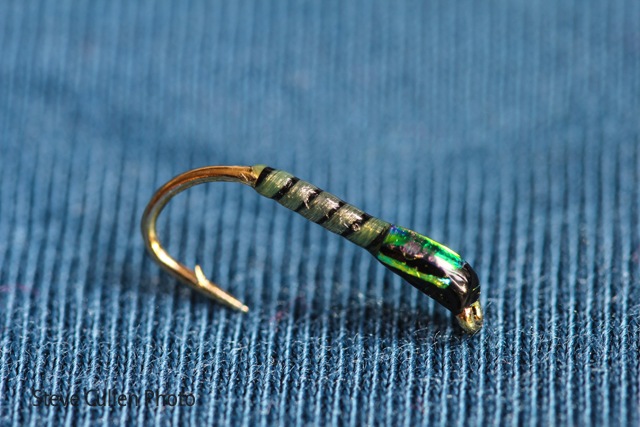
No.1 Buzzer
The muddy substrate on the bottom of reservoirs and large lakes is a paradise for the larvae of the vast number of species of non-biting midge (chironomids) that thrive anywhere that there’s water. In the UK these insects are commonly known as “buzzers” and trout eat huge quantities of them. This makes them an incredibly important group to imitate for successful stillwater anglers. When the larvae (bloodworm) leave the mud and ascend towards the surface to hatch as an adult midge, they transform into a distinctive pupal form. The pupae have a distinct, bulbous thorax and wing-buds. They often also develop a silvery sheen as the outer pupal skin begins to separate from the inner adult – just before hatching. As you can see in Steve’s photo above, his tying incorporates the distinctive segmentation of the naturals plus the wing buds and an attention-grabbing inclusion of the pearly “pre-hatching” shimmer effect.
As well as being successful as a cast of solely imitative patterns, buzzers such as this can also be a good option to combine with/sandwich between attractor patterns such as blobs and boobies. In fact, to cover the fundamentals of the wide range of tactics involved in buzzer fishing would require several articles (and could easily be turned into a book). Having said that, if you can cast this pattern out and get it to the eye-level of a buzzer-feeding trout; that will often be all that’s required.
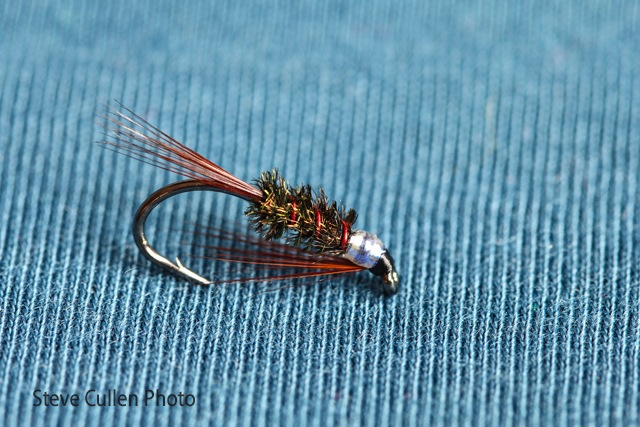
UV Diawl Bach
The original Diawl Bach (“Little Devil” in Welsh) was a disarmingly simple “straight-bodied” generic midge imitation. It has since spawned countless, incredibly-effective variations. The original pattern had a varnished red silk head and slim bunches of natural ginger cock hackle fibres at the throat and tail. Here, Steve’s pattern incorporates a number of excellent features that help to multiply its effectiveness. I talk at length in my book “How to Fool Fish with Simple Flies” about a concept I’ve labelled “Anti-Camouflage” and this pattern is a near perfect example. On top of exaggerating certain trigger points of the natural insect pupae (segmentation and often the presence of red pigment) – the high-contrast hot-spot does a very important job.
Basically, if you’ve ever seen the density of midge pupae that can exist in rich lakes, how do you get yourself noticed? If your imitation is too perfect it becomes camouflaged and just blends in to the hundreds of thousands of natural insects. So, you’ve only got two weapons – the way you move your flies and the inclusion of attention-grabbing colours.
The trick is to tread the fine line between attracting attention and becoming unrecognisable as “food”. But that is what the rest of my book is about ha ha. Other things to note are that, in the water, midges often hold their body straight (so you shouldn’t always default to the classic curved body tyings for buzzers). Also, these flies can be presented on any density of line – from drifting round naturally on the breeze on a floater – right down to sandwiching between attractor patterns on long leaders and fast-sinking lines.
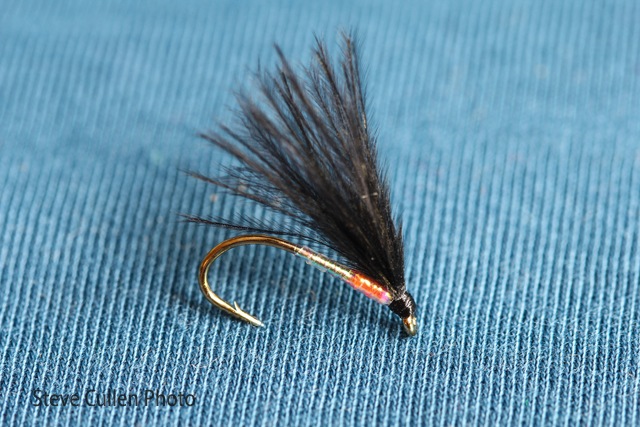
Orange Spot Mylar Cormorant
We all know how deadly real cormorants can be to trout, so there’s some typical British black humour in the name of these deadly trout flies. I mentioned above, when talking about Steve’s UV Diawl Bach, that movement can also be a weapon in the war of competing for a trout’s attention. In these patterns we are balancing on the fence between “attractor/lure” and “natural/imitative”. The way I’d characterise it is “suggestion of life”. What I mean is, they tend to be patterns that combine several signals that you’d normally find in living prey (from pin fry to buzzers).
The sparse marabou wing provides a subtle wiggle, the orange hotspot and translucent mylar body also suggests soft bodies and internal organs (plus carotene – the orange pigment often found in nutritious prey). Again, whether pulled aggressively and used to provoke a “lured” reaction or whether “twiddled” more slowly and “allowing the fish to take them for what they want them to imitate” (letting the fish fill in the blanks for themselves if you like); these are exceptionally effective flies.
That is why the idea of “Biohacking your fly fishing” is so useful; those principles apply across the board from Competition River Fishing through Tenkara to Irish Loughs, English Reservoirs and beyond to Saltwater Fly Fishing too…Don’t limit yourself to one label or look down your nose at other schools of fly fishing (that’s not how to become a good and creative fly fisher).
Dry Flies for Rivers
Although I’ve included this selection under the modern trout flies heading, anyone with even a small interest in fly fishing for trout knows that there’s a huge amount of history sitting behind “dry flies for trout”. Whether it’s talking about Admiral Nelson or Frederick Halford fishing on London’s River Wandle (and the home of the “Carshalton Dodge” of false-casting what is believed to have been dry fly patterns).

…or whether it’s that man Halford again sending English Chalk-stream patterns to anglers of the Catskills – which were modified by folks like Theodore Gordon to be more suitable for the faster, turbulent flows (as described in this great article by Mike Valla on the Quill Gordon and some of its history).
There’s even a claim of the earliest formally-recorded use of a floating dry fly by James Ogden on the River Wye in Derbyshire.
Basically, there’s an entire library of books that have been published on the many fascinating – separate and overlapping – histories of dry fly patterns and fishing. Of course, it is tempting to add to that huge stack of literature with more of the same here…but I wanted to give you something a little different – something that will give you a real edge in your next fishing trips.
For this article I’m soon going to hand you over to Paul Procter – an angler that I’ve gone on record to say, when it comes to targeting wild trout with a dry fly, is possibly one of the best to ever have done it. Period. Notice that, even in this modern (and supposedly “clear-cut” category of dry fly); Paul introduces a classic wet fly that he fishes as a “damp dry”. That is, glued (semi-swamped) into the surface film.
Controversial Trout Flies: When is a Dry Fly not a Dry Fly?
To highlight the subtlety of these differences, a “damp dry” is even a little different from the “emerger” style of dry fly that some folks consider a suspended nymph – and that others happily label as a dry fly that imitates the point of transition from nymph to adult insect (watch Hans van Klinken himself tie his all-time classic “Klinkhåmer Special” for a great example: https://www.flytyer.com/watch-hans-van-klinken-tie-klinkhamer-special/).
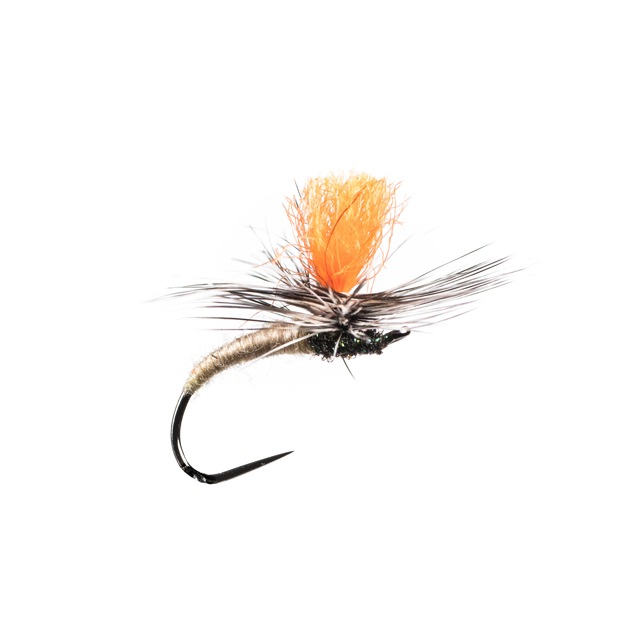
Emergers tend to have abdomens that penetrate the surface film, hanging below the surface (suspended by either clever hackles, wing “posts”- possibly made of buoyant material or even combinations of all these things).
Anyway – now you’re armed with all that it’s time to hand over to Paul so that he can explain his essential selection. Don’t be fooled by their simplicity – this has been hard-won by a process of ruthless stripping out of unnecessary excess. Trimming the fat is the right way to appreciate the value of what remains…
Paul Procter’s All Round Dry Fly Selection
Although Paul probably needs no introduction, you can catch up with him via Twitter on @paulprocter and via his Facebook profile.
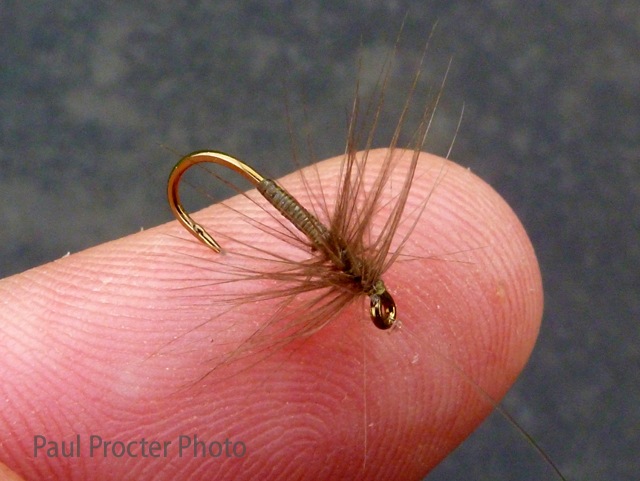
Stewart Style Spider
Hook: Partridge supreme dry size 14-16
Body: Olive gossamer silk well waxed
Hackle: Dun hen
Paul Writes: The concept of palmered hackled spiders is so they loiter close to the surface where either emerging upwing flies, or their drowned winged adults often accumulate. This Stewart Style dressing pretty much morphed into a “damp dry” some years ago on the River Wharfe. During a late afternoon spring day trout homed in to fly stuck in the surface film. Try as I might, I couldn’t buy a take, even with the ever popular CdC shuttlecock dressings. It was a single Stewart spider presented on a greased leader that did the trick.
Following this early success, I began tying these spider using premium grade hen hackles that whilst not webby enough for traditional spiders had that sufficient “bounce” about them to support a hook. Anointed with floatant this little gem sits right in the film. What’s more, its busy appearance appeals to fish holding in the faster parts of a stream. Best fished as single fly rather than the customary trio often associated with spiders.
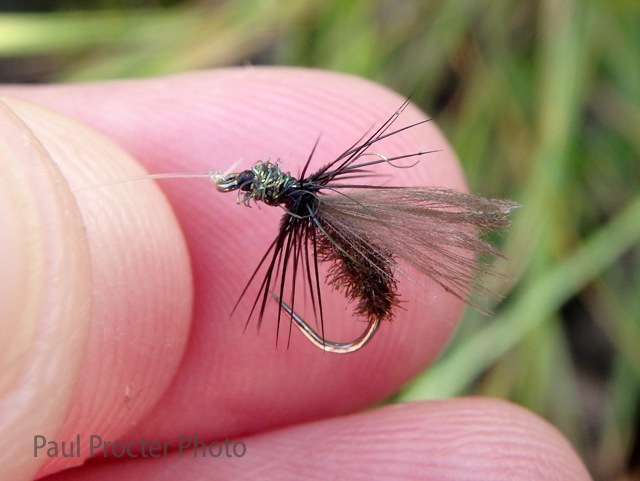
APT (All Purpose Terrestrial):
Hook: Partridge grub size 12-18
Thread: Black 12/0 Nano
Body: Peacock herl
Wing: Beige CdC
Hackle: Black cock
Head: Peacock ice dub
Paul Writes: I’d like to think my feet are firmly planted on the ground and therefore remain reluctant to name flies after myself. However, I’m immensely pleased and proud with the APT which came about a few seasons ago. Initially designed to fool black gnat/fever fly feeding trout, or grayling for that matter, it’s a winner when numerous species of land borne insects find their way onto the water, including ants. What’s more, it appeals to trout the World over where I’ve found success with it throughout Europe and as far afield as New Zealand.
Three strands of peacock herl from close to the eye (herl fibre is shorter here) are twisted together around your tying thread to make a robust, attractive body. Along with the curved hook, trimming away hackle fibres on the underside ensures the fly sits partially subsurface. Different shades of CdC can be used to cope with varying light conditions.
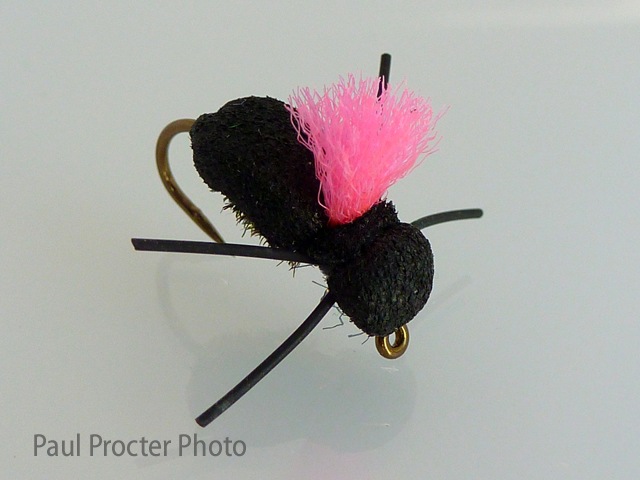
Foam Beetle:
Hook: Partridge supreme dry size 12-18
Thread: Black 6/0 Nano predator silk
Body: Peacock herl
Shellback & Head: Semperfli booby foam
Post: TMC aero dry wing
Head: Peacock ice dubbing
Paul Writes: Whilst fly hatches continue to hold their own in my part of the World, as upland streams are a regular haunt of mine, we’re extremely reliant on terrestrials too. Namely, it’s black gnats, hawthorn flies and various beetles that excite trout most. Although labelled a “beetle”, a slim version of this dressing is my go to when black gnats come tumbling. More than that, this buoyant dressing is a great search fly, especially when plopped down in noisy water as such a commotion often attracts trout. By the same token, this method usually sends fish scurrying if practiced on idle, flat water! (Editor’s Note: Yet another applicatio of the “signal:noise ratio” discussed in our Biohacker Series).
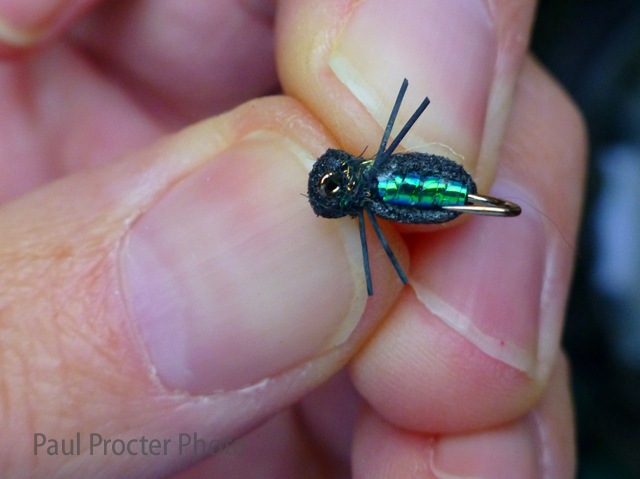
Whether you include rubber legs or not is entirely up to you. In truth, I have no hard evidence to suggest these appendages out-fish a legless version. On thing I’m adamant about including though is tuft of yarn as a sighter. I tie beetles with black, yellow, orange and white aero wing to suit various light conditions. For example, black shows up really well when casting into glare, whereas a white wing stands in the shadow of leafy boughs. An alternative is one tied using green lurex tinsel (see photo above)
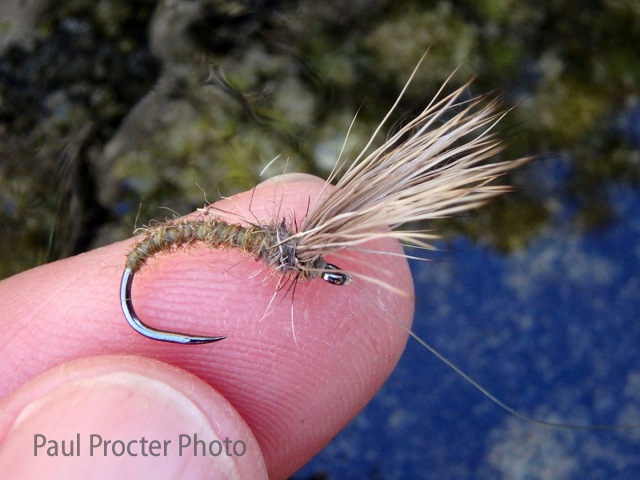
Wyatt’s Deer Hair emerger (DHE):
Hook: Kamasan B-100 or Partridge K4AY-SE #10-14
Thread & Rib: Danville’s primrose 6/0 Flymaster
Body: Fine dubbing of various shades (olive brown here)
Thorax: Hare’s fur dubbing
Wing: Deer/Elk hair
Paul Writes: Bob Wyatt pulled a blinding stroke when he created the DHE. As with most trout flies here, it’s one of those generic type dressings where size and colour can be altered to suit several hatch situations. For example a size 10-12 fly incorporating a dark tan body is reminiscent of march browns, or large brook duns. Conversely, a slender size 16 version using a rich olive dubbing fits in well with the likes of B-WOs or medium olives.
Bob advocates a scruffy fly that doesn’t even have the deer hair tips aligned. Such a dressing is perfect where a river quickens and the flows become boisterous. In fact, a variant of mine includes CdC in the wing too. Not for extra buoyancy you understand, it’s more to do with making your imitation appear more “buggy” and alive! Where flows fall slack, I’m confident with a slimmer tying bearing a sparse wing. The pattern you see here is obviously designed for the rapids.
(Editor’s Note: again, Paul’s notes on dressings for rapids vs. slack flows are a perfect match to the signal:noise guidelines we apply using simple biological principles to fly design and presentation).
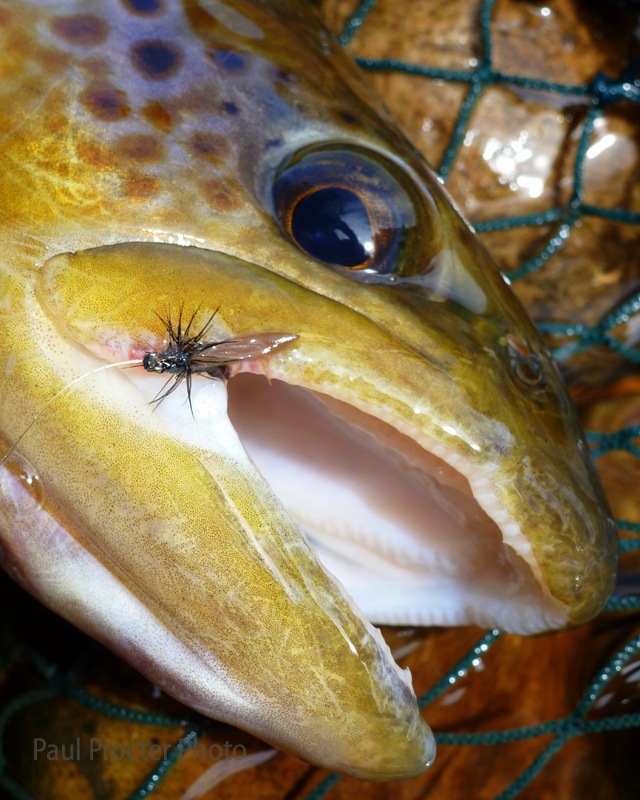
Weighted Trout Flies Part 1: Nymphs for Rivers
If you haven’t already studied our free tutorials that give you the building blocks of European nymph fishing, wet fly and downstream dry fly, then you’ll find the presentation skills that you need for the patterns on this page by Clicking Here to Subscribe.
One of the most iconic nymph style patterns of the modern era are what has become widely known as the “Czech Nymph” class of flies. Now, these are highly effective for both trout and grayling; but deep in their DNA they are probably best identified as a secret weapon for extracting shoals of grayling under competition conditions. So, for that reason I’ll probably save most of the details of those patterns for a separate article on flies for grayling. In the meantime, you might be interested to know that authentic Czech nymph patterns are available from Gold medal winner Jan Siman from his long-established online shop.

Probably the most famous (and most-copied/endlessly-modified) trout fly of all time is the Sawyer’s Pheasant Tail Nymph. Originally tied by English Chalkstream Keeper Frank Sawyer – using fine copper wire in the place of tying thread – this subsurface pattern has shaped (or has parallels with) almost all developments made in what we see today in modern trout nymph patterns.
On the Youtube channel run by Frank Sawyer’s descendants you can see the ONLY known footage of Frank himself tying his famous pheasant tail nymph:
The key points are that, as well as increasing the density of the dressing to aid sinking, Frank’s use of very simple materials (just wire and pheasant fibre) and a basic “impressionistic” shape created a highly effective trout fly.
The form of his fly was arrived at AFTER he understood the function that was required of it.
This matches the Bauhaus philosophy that “Form Follows Function” (and not the other way around!!) – which might seem a weird connection to make; but is actually a powerful way to improve your fly fishing success. For example…
With the rise in popularity (and the undoubted effectiveness) of tungsten beads as a way to weight nymphs, there is an almost endless sea of “bead head nymph” trout flies to choose from. The way to cut through that infinite choice is to look at the functional benefits of each design.
Sometimes it is both a “hotspot” target point (either for the trout or for the angler!) as well as a way to add lots of weight in a slim profile. Of course, the size and shape of each nymph will make it suitable for imitating particular local hatches (and colour can also play a part in that imitation too).
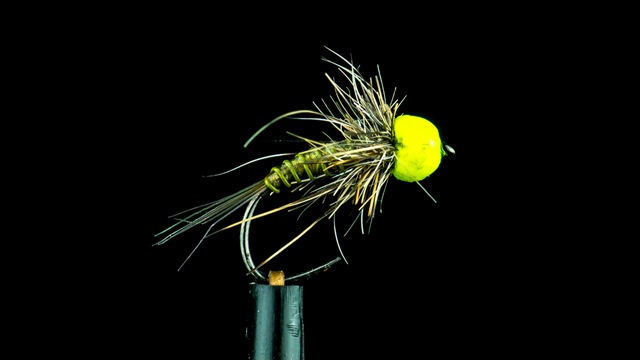
In the above pattern, the bright yellow bead can attract the attention of the fish – but it is also a useful underwater “sighter” for the angler when you are trying to spot when a trout eats your fly below the surface. That is particularly true when you are only making an educated guess as to where the fish is lying in the river.
That functional understanding of fly patterns (and how that is used to trigger the biological reflexes of your target fish) is the entire focus of our book “How to Fool Fish with Simple Flies”. Here, I wanted to give you one of the best possible examples of that “form follows function” mantra.
When you misunderstand the function of grayling & trout flies
I’ve seen it written many times in online discussions that “I don’t see what’s so good about Perdigon nymphs” or some variation of “I’ve never really found Perdigon nymphs effective”. The problem here is likely to be a complete misunderstanding of the very specific application that such nymphs were designed for by the French and Spanish anglers of the Pyrenees. First of all, let’s look at some absolutely lovely examples of nymphs from Paul Molloy that follow the design features first popularised by these “Perdigon” (meaning “lead-shot”) nymphs.
N.B. You can check out tons more of Paul’s fantastic ties by following his instagram.
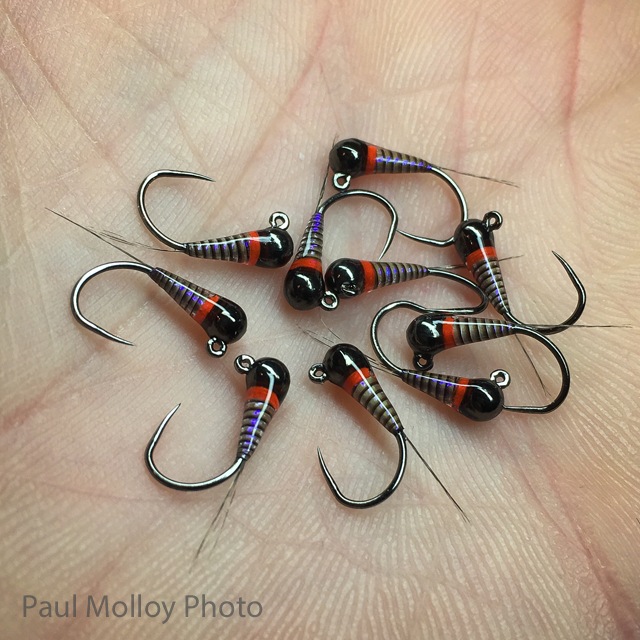
Paul Molloy’s “Perdigon” Stripped Quill Variant
Hook: Dohiku claw jig size 16
Bead: 3mm slotted Black tungsten
Thread: Uni 8/0 fire orange
Tail: Coq De Leon medium pardo (4-6 fibers)
Body material 1: Natural stripped peacock quill
Body material 2: Troutline’s flat perdigon tinsel in ultraviolet (Over quill)
Resin: Solarez thin
Finishing coat: clear Sally Hansen hard as nails nail polish
As well as including attractive/attention-grabbing reflective properties in the UV tinsel and the lovely segmentation effect of the quill-body, what is the over-riding impression you take from Paul’s flies? Can you see how smooth and glossy they are?
That hard, smooth resin coat, a lack of hackles or dubbing sticking out perpendicular to the hook shank and the dense tungsten bead all add up to create a very useful effect: The ability to sink incredibly quickly while still being a small, slender fly.
The tails are the only projections from the body but – because they are in-line with the body – they act more like a rudder (or the tail of a bottle-rocket!). That means they don’t slow down the sink-rate very much at all. The tail might even help to minimise turbulence and actually increase sink-rate.
Now that you know how the “form” of that style of nymph creates those functional characteristics, it is much easier to understand the problem that these flies were designed to solve…In fast (and/or deep) streams, you need to get your nymph to the eye-level of the fish FAST.
With many designs of flies, this means bulking up the number and size of tungsten bead(s) that you need to get your fly down…But what if fish are really feeding heavily on small, olive mayfly or small stonefly nymphs? Until the invention of this style of dressing, your main options would be to add a very heavy point fly (or even split-shot) to your tippet. Then, if allowed by local rules, you could add small imitative nymphs to the dropper or droppers on that tippet.
Now you’ve got the option of maintaining a fast sink rate, without needing to go straight to a huge, bulky “brute force” pattern.
Also, the jig-head design will help to keep the hook shank and point angled up away from the riverbed; so there could be a little bit less chance of it hanging up on the riverbed compared to other hook and weight designs. However, they are certainly far from “snag-free”.
Look out for patterns such as the “Copper John” or “brassies” that also follow an impressionistic profile and a deliberate increase in density of materials/streamlined profile to get a quick sinking nymph that is attractive to trout and grayling.
Pay attention also to the inclusion of hot-spots in many bead-head nymphs (as well as the opposite drab colour schemes that can be required to avoid spooking fish). Those variable degrees of camouflage through to deliberately attention-grabbing colours are another key theme in “How to Fool Fish with Simple Flies”.
Trout Flies for Small Stillwaters
Around the world, there are many small lakes and ponds that are stocked with trout. Sometimes these are run as bait fisheries, but often they can be a gateway into the world of fly fishing for many folks. Indeed, there are plenty of anglers who take the development and pursuit of the tactics necessary to succeed on these fisheries as their main focus in the sport. If you dismiss these fisheries as “easy” – you’ve probably never fished on a catch and release, fly-only small stillwater fishery. They can be some of the hardest venues to crack – as the fish have seen all the regular approaches many times over.
In fact, as long as you can avoid spooking a wild fish, they are generally easier to get to actually take a fly than the average resident stock fish in a small C&R venue…
I can see the angry comments already, but I stand by that observation. At the same time, fish that have been stocked very recently are inherently curious and, for a while, are both difficult to spook and easy to catch. Those characteristics are, undeniably, helpful when you’re trying to give a beginner their very first experience of landing a trout.
So, with the full range of possible challenges (from easy to as hard as it gets) in mind, here’s Ben Fox to guide you through some great choices to employ on these small, stocked lakes and pond venues…
Ben Fox’s Small Stillwater Selection
Ben Fox is the owner of Fly Guy, a company which offers fly fishing guiding and coaching in Yorkshire and the surrounding counties. An all-round angler Ben has represented England at youth level and competed in the national loch style final. An Airflo endorsed guide he enjoys targeting trout in all manor of situations and has picked out some of his top small stillwater water patterns below.
To find out more about Ben and Fly Guy visit: www.fly-guy.co.uk or www.facebook.com/BenFlyGuyFox
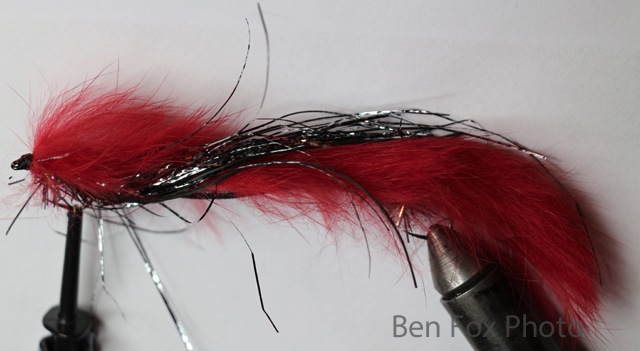
Dennis the menace snake
Hook: 2x size 8 hooks (cutting the bend off if needed)
Thread: Black 8/0 uni thread
Body: Black flash straggle fritz
Spine: Black braided loop material
Wing: Red zonker strip
Throat: Barred silver and black flash with black spandex legs
Ben Writes: Snakes have to be one of the biggest flies you’re likely to use on a small water. Often smaller is better but other times a change to something big and garish can often change your luck and sort out the bigger fish in the lake. This particular variety follows the popular Denis the menace colouration and the zonker combined with the spandex legs offers incredible movement.
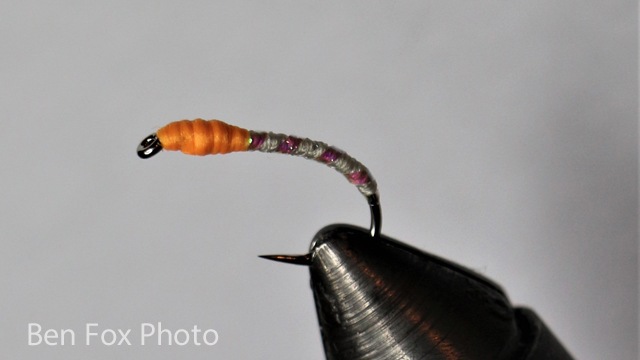
Peachy Okey Dokey
Hook: Size 10 short shank
Thread: White
Head: Glo brite no 8
Rib: Pearl mylar
Ben Writes: A variation of the classic small water buzzer pattern. A very attractive pattern that works well under an indicator, straight lined or washing lined.
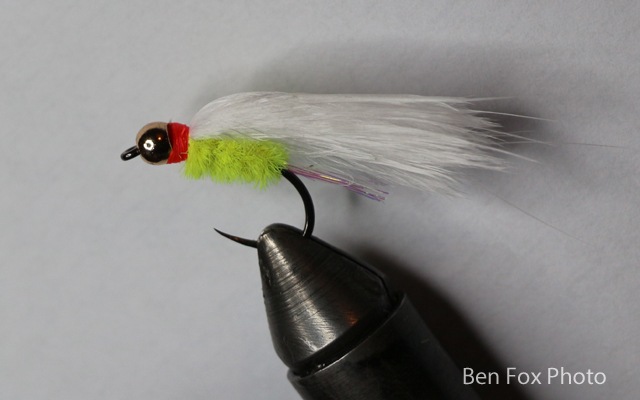
Cat’s Whisker Beadhead
Hook: Size 10
Thread: 8/0 fire orange uni
Bead: Gold 3mm (brass or tungsten depending on the depth the fly is to be fished)
Body: Chartreuse chenille
Wing: White marabou
Tail: Pearl flashabou
Ben writes: The classic trout lure. Hundreds of variants are tied and used, this is my banker pattern. The orange tag really has made a difference at times with this fly taking countless trout up to double figures.
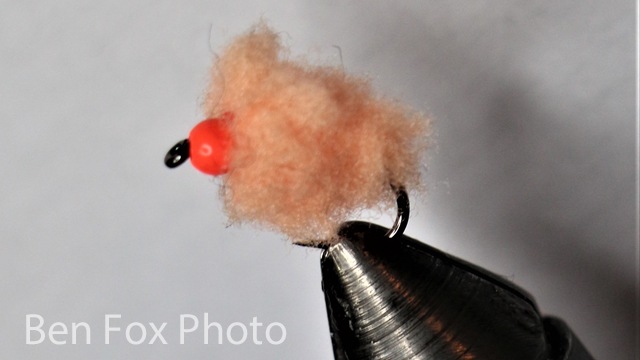
Sockeye special
Hook: Size 12
Head: 2.5mm orange bead (brass or tungsten depending on the fishing depth)
Thread: Fire orange 8/0 uni thread
Body: Eggstacy: Sockeye colour
A simple deadly pattern that has become my go to for getting my clients takes! Tied with eggstacy from Fly box in the sockeye colour with an orange bead it has taken hundreds of trout this season, a real banker pattern fished under a bung or on a slow retrieve.
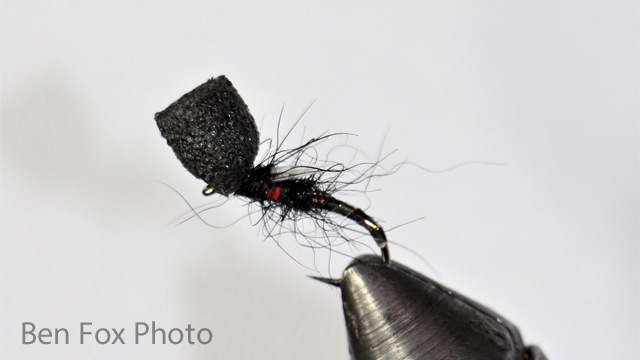
Foam emerging buzzer
Hook: Size 14
Thread: Black 8/0 uni
Head: Black booby cord
Body: Black thread Rib: pearl mylar
Cheeks: Red goose biot
Wing case: White goose biot
Thorax: Black seals fur
Fishing dries is my favourite way of catching trout. Buzzers are the main hatch on most small waters and fish rely on these and terrestrials for the majority of their surface feeding. This fly fishes in the surface layers, perfectly imitating the small buzzers coming off all year round on our small waters.
Streamers for River Trout
Martin Smith’s Streamers
While folks (such as Kelly Galloup) have popularised the use of streamers as trout flies in rivers in the USA – and world-class competition anglers from Continental Europe have streamers as a major “go to” weapon in their arsenal – it is fair to say that English fly fishers have been slower to embrace and benefit from this fascinating branch of fly fishing.
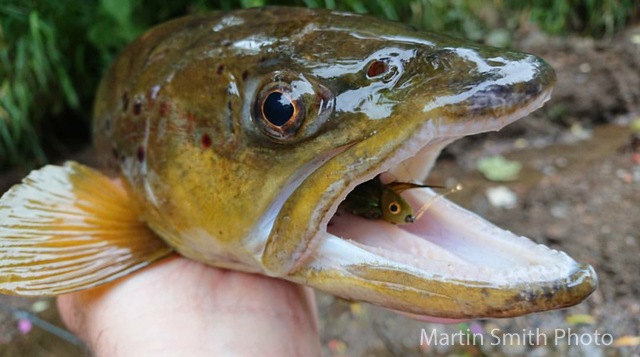
If you’ve not yet heard the name Martin Smith (or of the pattern “Martin’s Minnow”), well, you’re in for a treat and also – get with the program! You’re playing catch-up now…This is because Martin has quietly been developing, testing, destroying, re-building and advancing a formidable system of fishing streamers on a fly rod (for most things that swim, from pike to perch to zander as well as trout).
You can see a whole lot more on Martin’s Instagram account and his Facebook page
Martin says:
I fish the majority of my streamers across the river as opposed to swinging them, with trout being notorious tail nippers and holding in a lie they have a very brief window of opportunity to hit a streamer unless they decide to chase/hunt it down, as such I prefer to show them as much profile of the fly as possible so they can see what they’re lunging at, I liken this to looking at a pencil side on (fishing across stream). Compare that to looking at that same pencil end on (swinging a streamer) and you’ll see that fly profile becomes a whole lot smaller!
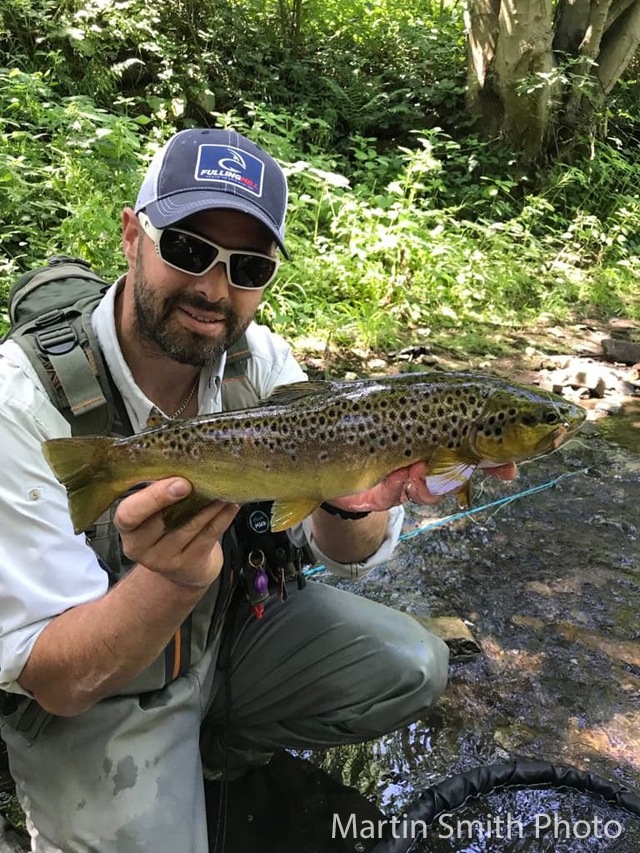
Now to some of my most trusted patterns for trout…
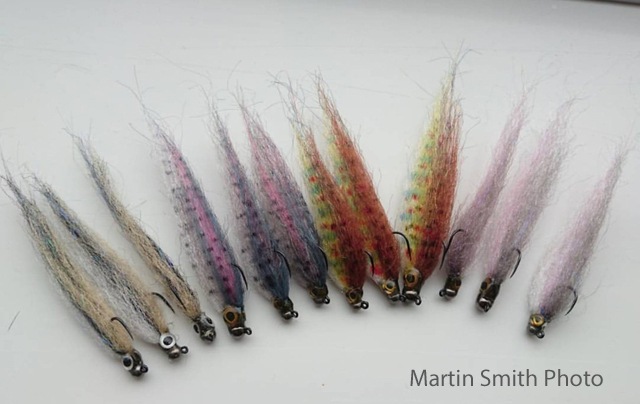
Martin’s Minnow
Martin Writes: The Martins Minnow came about for a certain situation fishing a ledge on a plunge pool that had a strong tongue of water through the centre of the pool. This meant I needed to incorporate a heavy tungsten bead (4-5.5mm) to drop quickly through the water column and get into the zone. As with the “buggered sculpin” below – this minnow is deliberately tied with the profile and size to match with a natural minnow to key into a trout’s search pattern, also highly effective for chub and perch. PG note – for more on “search patterns” or “Prey images” used by visual predators – check out our “Fly Fishing Biohacks” series of videos.
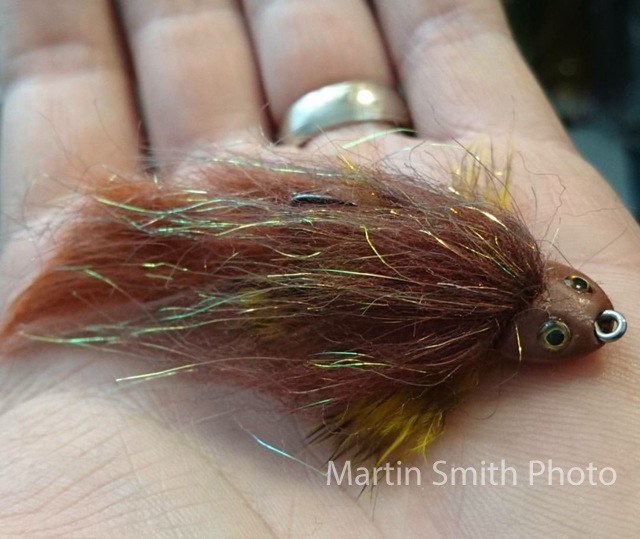
Buggered sculpin
Martin writes: A pattern I tied to closely match the search pattern of trout hunting out naturals around rocks. Generally fished slightly up and across and allowed to jig and bump bottom as well as being stripped back.
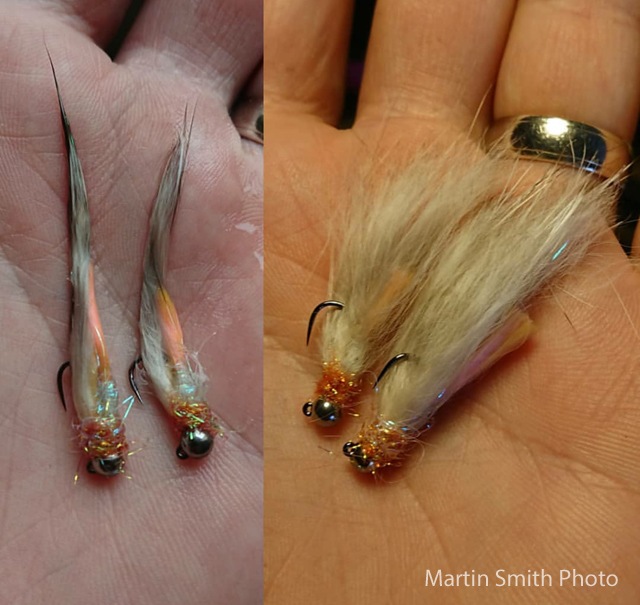
Micro streamer (pictured wet and dry)
Martin writes: This is one I started playing about with late in the summer of 2018 seeing as it was so hot and dry I felt smaller streamers might tempt a few extra fish. These were usually fished on a French leader with a nymph on a dropper above but it was mostly the streamer that took the fish, I later went on to catch several good fish using them on light (3-weight) rods.
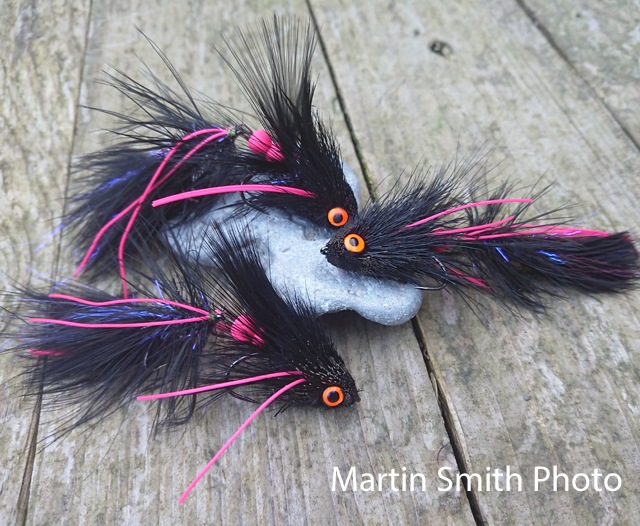
Sex Dungeon (!)
Martin writes: And finally Kelly Galloup’s “Sex Dungeon”, a larger articulated pattern. It has excellent movement especially when stripped through various current lanes but I mostly use this when searching out larger fish in specific situations, searching the far bank on a more specialised streamer setup incorporating a fast sink tip line to drag it straight down. After a few jerk strips of there’s no interest it’s fished back quick and back out to the hot spot, a fast and frantic way to fish looking for a reaction strike…
Thanks Martin – and what a pattern (and name) to finish our run-down of trout flies!!
Suppliers
Now to list where you can source materials and flies for yourself…
Materials
Martin Smith uses a range of modern fibres from Funky Fly Tying: https://www.funkyflytying.co.uk/
North American Supplies of Pearsall’s Silk (for North Country Flies): Click for Selections
Custom Trout Flies
Traditional and Modern Irish Flies: Jackie Mahon via Mahonjackie@gmail.com
North Country Flies, Nymphs, Dries & Info: Robert Smith at www.northcountryflies.com
Ben Fox Flies for All Venues: www.fly-guy.co.uk
Martin Smith Streamers MS Custom Flies: www.facebook.com/MScustomFlies/
Authentic Japanese Kebari Personally Tied in Derbyshire: Discover Tenkara Kebari
Czech Nymphs from Czech Republic: Jan Siman Shop
Commercial Fly Suppliers
Fulling Mill: www.fullingmill.com
Orvis (for extensive in-store selections): www.orvis.com
John Norris (Penrith) immense selection in their walk-in store: www.johnnorris.co.uk
Please Let me know via pg@discovertenkara.co.uk of any suppliers you think should appear here and feel free to leave comments below on any topic covered in the article (you don’t need an account – just confirm your human by adding two numbers together!).
Paul

Brilliant article pleasure to read
What a nice man you are Mike – thank you very much and a very Happy New Year to you.
Paul
Great reading and very useful. Thanks for the work you put into this Paul.
Paul – you’ve very welcome and the fact you found it useful enough to take some time out and comment really does make it worthwhile 🙂
Paul
That’s a great read. I’m impatiently waiting the grayling one. Interestingly enough, when you mentioned the ” form follows function” part, it reminds me my architecture studies. And there you go, quoting bauhaus school… Loved that cross reference!
Thank you Thomas – I’m glad that the weird diversions, sideways jumps and connections that fall out of my brain onto the page might sometimes make sense to others!
Paul
Terrific article Paul, thanks for taking the time really enjoyed that. Reminded me of a few patterns I’d forgotten about but stood me well at the time. Worth another look at with fresh eyes and changed perspective.
Thank you Tony; really glad that you enjoyed it and that there might be some seeds of inspiration for new or adapted patterns from all over the trout fishing spectrum.
Paul
Thanks guys for all the work to pull together all this interesting & useful information about trout flies. To much to take-in all in one go. Or even two.
I’d like to mention some fun fly stuff recently posted by Todoroki Toshiro-san on is kebariandfly blog. At the bottom of the blog post he provides a link to a 100 page pdf file about the concept of Vernon S. “Pete” Hidy’s Flymph. (a name I believe Mr. Hidy coined in 1971) Mr. Hidy was the founder of the Fly Fishers Club of Oregon.
[What is fly when it’s not a dry fly and it’s not a nymph wet fly? It’s a flymph. Something in between the two. Not a match the hatch imitator fly, but primarily a mimic. Like a kebari that can be one or the other. Depending on how it is fished.]
Beginning on page 52 under the heading, ‘Antique flies from the Hidy collection’, you’ll find several pages of interesting full page fly photos. (the large format was chosen on purpose to show the details not easily seen in small photos nor properly understood by written instructions) Many are similar or variants of the ones shown here. They’d probably fit nicely here somewhere within your Traditional Fly section. Plus there is a lot of additional fun historical stuff.
Google will easily find Todoroki-san’s blog post by searching for the title of the blog post. [ “2019 狩猟鳥利用毛鉤” ]. = 2019 Game bird utilization for kebari, I think. Or just do a google search for [ flymph ] to find other information about them. To my surprise there is a lot of online interest in the concept.
David – as ever I will check out your recommendations; they are always worthwhile. If the content isn’t copyrighted (and/or if Todoroki-sama would like it to be included) then I’ll happily add more to this article over time.
Best wishes and many thanks,
Paul
Loved this article so much I “favorited it” to be able to go back to it in an instant.
Finally understand the different flies.
Thank you :))
Hey Marie – thank you so much for the feedback and I’m really happy that the article was useful for you.
Paul